Indonesia Travel Guide: Best Time to Visit Bali and Wider Indonesia, and More
About to plan an Indonesian adventure? Here are some essential travel tips for Bali and beyond, including the best time to go to Bali, what to eat and drink there, and more.
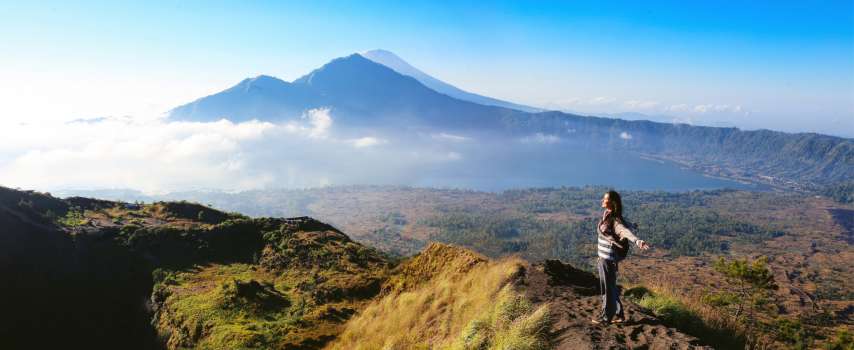
Source: Getty
Captivating culture and island charm await the nearly one million Aussies who venture to Indonesia each year. And, the country welcomes excited travellers with big smiles and open arms.
Of course, Bali is among the most popular destinations for travellers from Australia who visit Indonesia. Known as the Island of the Gods, one visit to Bali will cement its place in your heart: the landscapes, the culture, the cuisine, and the adventures that await.
Just one of Indonesia’s 17,000 captivating islands, Bali is a holiday haven for backpackers, honeymooners, families, soul-searchers and everyone in between. And it’s essentially Australia’s holiday house, being one of the most-visited international destinations for Aussies each year.
But if you’re wondering “when exactly is the best time to visit Bali?”, “do I need a Bali visa when visiting from Australia?” or “where should I stay for the best experience?”, this guide is here to help.
Read on to start planning an adventure like no other.
“At Cover-More, we insure more Aussies travelling to Indonesia than any other international destination. Bali, in particular, is a well-trodden path for many Aussie travellers.
But, whether you’re setting off on a quick island holiday or an intrepid adventure through other parts of Indonesia, it’s important to do your research before you travel to help ensure you have a safe trip.”
Rodger Cook, Cover-More's General Manager of Global Security
Jump to:
- Essential information about Indonesia
- Best time to visit
- Cultural events to experience
- What to see and do in Bali
- Best attractions and experiences in Indonesia
- What to eat and drink
- Top airports to fly into
- Getting around Bali and beyond
- Best areas to stay
- What to pack
- Phrases to know before your trip
- Public holidays to be aware of.

Source: Getty
Essential information for your Bali and Indonesia travels
Ready to plan your adventure? While you’re likely pouring over travel guides and blogs to discover all the best things to do in Bali and beyond, it’s important not to forget the basics.
Whether you’ll be travelling to a resort with your family, getting some well-deserved R&R, or backpacking your way around Indonesia’s most fascinating places, a little preparation will help ensure your travel experience is smoother and more enjoyable.
Let's take a look at some key information to help you understand the best time to visit Bali, Indonesia entry requirements and other essentials you should know before embarking on your journey.
Language
Indonesian is the official language, though over 700 languages are spoken across the country. English is widely used and understood in tourist destinations such as Bali.
Currency
The official currency is the Indonesian Rupiah (IDR).
Visa Requirements
Australian passport holders visiting for tourism can apply for an “e-Visa on Arrival” no later than 48 hours prior to travelling to Indonesia. You can still apply for a regular “Visa on Arrival” (VOA) at certain international airports, seaports and land crossings, including Bali and Lombok. Check Smartraveller for more information.
Driving Side
Similar to Australia, Indonesians drive on the left side of the road in Indonesia. If you are planning on driving in Indonesia, don’t forget to get familiar with local traffic laws and license requirements. It’s also smart to consider a comprehensive travel insurance plan with rental vehicle cover.
Electric Plug
The standard electrical plug used in Indonesia is the Europlug, with two round pins. Make sure to take a universal travel adapter to charge devices.
Electric Voltage
As in Australia, the standard voltage in Indonesia is 220-240 volts.
Dialling Code
The international dialling code for Indonesia is +62. You can purchase a local SIM card for your phone upon arrival for easier and more affordable communication.
Time Zone(s)
Bali, Jakarta and Surabaya follow Central Indonesia Time (WITA), which is GMT +8.
IMPORTANT: From February 2024, Indonesian entry requirements will change, with international travellers set to pay a new tourism tax upon arrival in Bali.
The fee is IDR 150,000 – or approximately AUD$15
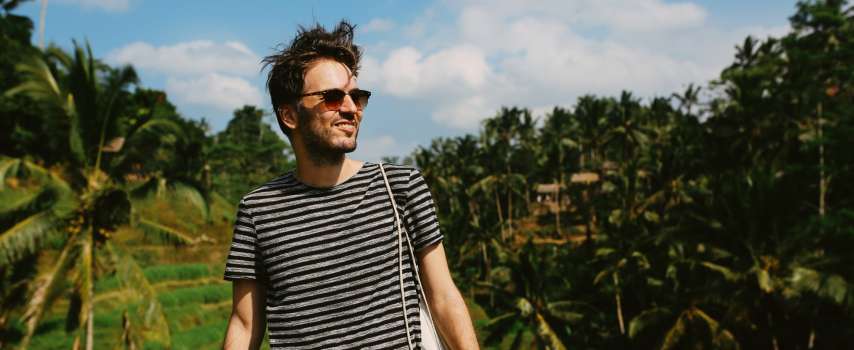
Source: Getty
The best time to visit Bali and Indonesia
Wondering what’s the best time to go Bali? You’re not alone – each year thousands of travellers living in Australia make their way to this stunning Indonesian island. Whether you’re looking for the cheapest time to travel to Bali or hoping to avoid the worst time to travel to Bali in terms of weather or crowds, read on to get all the information for this popular destination, and wider Indonesian hotspots.
High Season
- Dry and sunny weather, the best weather to go to Bali
- Perfect for beach trips, hiking and outdoor activities
- Busiest time of year
- Higher prices
Low Season
- Wet season, with high rainfall
- Fewer tourists
- Cheapest time to travel to Bali
- Christmas and New Year period experiences high season conditions and prices
Shoulder Seasons
- An ideal balance of good weather and lower prices
- Medium crowds
So, when’s the best weather to go to Bali?
Similar to the tropical regions of Australia, Bali has two seasons: wet and dry. The weather is hot and humid all year long, with little fluctuation in temperatures and reaching an average high of 26-30C. Wet season is typically November – April (with December and January being the wettest months). If you’re travelling during this time, you should prepare for more rainy days.
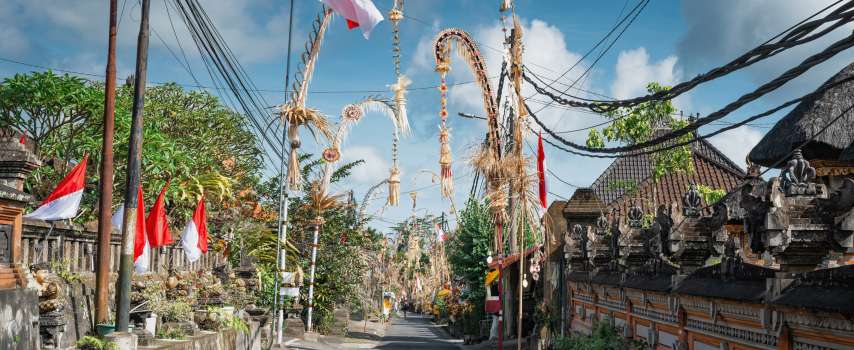
Source: Getty
12 incredible cultural events to experience in Bali and Indonesia
Culturally diverse and home to over 17,000 islands, Indonesia offers rich history, stunning natural landscapes, and vibrant culture. If you’re deciding the best time to visit Bali or other destinations throughout Indonesia, here are 12 annual events you may enjoy:
#1. Tumpek Kandang (Every six months, Bali)
Tumpek Kandang is a Hindu ceremony held to honour animals and their role in Balinese culture. This event is celebrated every six months and involves offerings, prayers, and blessings for domestic animals. It's a unique cultural event that showcases the strong bond between humans and animals in Bali.
#2. Galungan (February to March)
Galungan is a major Hindu holiday celebrated across Indonesia, but is especially vibrant in Bali. It marks the victory of good over evil and is celebrated with colourful decorations, offerings, processions, and ceremonies. It's a great opportunity to immerse yourself in Balinese culture and witness traditional rituals.
#3. Nyepi (March, Bali)
Considered one of the most important holidays in Bali, Nyepi is the Balinese Day of Silence. It's a day of self-reflection and meditation where all activities come to a halt, including no travel and no entertainment. An official public holiday, it's a unique experience to witness the entire island come to a standstill and reflect on the importance of balance and harmony in life. The following day is then celebrated as New Year’s Day in Bali.
#4. Bali Spirit Festival (May, Bali)
Held in Ubud, the cultural heart of Bali, Bali Spirit Festival is an annual five-day event that celebrates yoga, dance, and music. Bringing together people from all over the world to participate in workshops, dance performances, and concerts, the festival promotes mindfulness, health, and wellness while celebrating Bali's culture and spirituality.
#5. Tanah Lot Festival (June, Bali)
Held in Bali's iconic Tanah Lot Temple, this festival is an opportunity to experience Balinese culture with traditional dances, music performances, food stalls, and a grand procession to honour the gods.
#6. Ubud Food Festival (June, Bali)
Ubud Food Festival is a must-attend event for foodies. Held in the charming town of Ubud, this festival celebrates Indonesian cuisine through cooking demonstrations, workshops, food tours, and more. It's a great way to experience the diverse flavours of Indonesian cuisine.
#7. Bali Arts Festival (June to July, Bali)
The Bali Arts Festival is an annual celebration of Bali's diverse arts and cultural heritage held in Denpasar, the capital city of Bali. It showcases traditional arts and cultural performances, including dance, music, theatre, and more.
#8. Sanur Village Festival (August, Bali)
An annual event that showcases the beauty and culture of Sanur, Bali's oldest beach resort destination, this festival celebrates the local community through traditional performances, food stalls, art exhibitions, and more. It's a great way to experience the authentic side of Bali
#9. Flores Kelimutu Festival (August, East Nusa Tenggara)
The Flores Kelimutu Festival celebrates the cultural diversity of East Nusa Tenggara, home to the famous three-coloured lakes in Kelimutu National Park. Showcasing traditional music, dance, food, and cultural exhibitions from various ethnic groups in the region, it's a great way to experience the unique cultures of Flores.
#10. Kuta Karnival (October, Bali)
If you're looking for a fun beach festival, Kuta Karnival is the event for you. Held every October in Bali's famous Kuta Beach, this festival is a celebration of music, cultural performances, food, and beach activities – and that iconic party atmosphere
#11. Ubud Writers and Readers Festival (October, Bali)
A splendid event for literature enthusiasts. Ubud Writers and Readers Festival brings together writers, readers, and thinkers from all over the world to participate in discussions, workshops, and performances. It's a great opportunity to engage with the local and international literary scene while enjoying the beautiful surroundings of Ubud.
#12. Borobudur Cultural Festival (October, Java)
If you're visiting Central Java, make sure to attend the annual Borobudur Cultural Festival. This event celebrates the rich heritage of Central Java through traditional performances, cultural exhibitions, and a grand parade. It's a wonderful way to learn more about the history and traditions of this region.
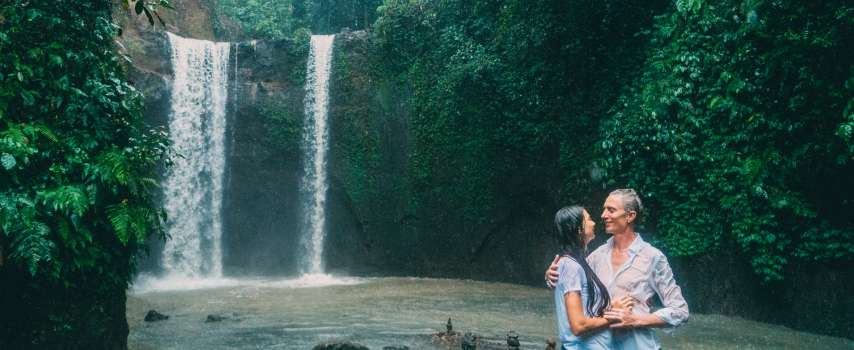
Source: Getty
10 best things to see and do in Bali
You’ve landed in paradise. What next?
Bali is the ultimate playground for adventure seekers, relaxation enthusiasts, and anyone looking to inject a hefty dose of fun into their lives. Whether you’re seeking sun, culture or life in the jungle, it’s time to discover the best things to do in Bali.
#1. Soak up culture and history at Bali’s many temples
While it might be a destination Aussies come to relax and blow off some steam, Bali is a deeply spiritual place – so visiting a temple or two is a must. Some must-visit temples include:
- Tanah Lot: an iconic Hindu temple located on a rock formation just off the coast of Bali, with breathtaking ocean views and a popular spot for sunset.
- Ulun Danu Baraton Temple: a lakeside temple in central Bali, this is one of the most photographed temples on the island.
- Tirta Gangga: known as the water palace, this temple in East Bali is home to sprawling water features and koi ponds, along with impressive views of Mount Agung.
- Lempuyang Temple: famous for its Gate of Heaven, this spot is popular for photographers.
- Uluwatu Temple: occupying a breathtaking location on the clifftops of Uluwatu, visit around sunset to take in the iconic views – and take a lot of photos.
#2. Retreat to Ubud
Considered to be the cultural heart of Bali, Ubud is famous for its lush green rice paddies, Balinese architecture, and spiritual retreats. The Monkey Forest is one of the area’s most popular attractions, a sanctuary and natural habitat of Balinese long-tailed monkeys.
Another must-visit is the Tegallalang Rice Terrace, which offers walking trails to explore and a giant swing over the sparkling emerald gorge that has become well-known Instagram spot.
#3. Go surfing
Whether you’re here to ride world-class breaks or learn to surf, Bali offers something for everyone.
Kuta Beach is one of the best places to learn to surf, with dozens of board-rentals and affordable surf schools. Big wave surfers should head to the southern beaches of Bukit Peninsula, such as Uluwatu.
Prefer kite landboarding? The best time to go to Bali is June to August, when wind conditions make it prime kiting season.
#4. Bliss out by the beach
The fact that beach-loving Aussies flock to the sands of Bali says all you need to know, but if you’re coming to Bali for the beaches be sure to put a few of these on your radar.
- Seminyak: 5km of golden sand scattered with beach clubs, stylish bars and restaurants, and five-star resorts.
- Kuta: a famous tourist hotspot packed with things to do.
- Balangan: easily accessed from Kuta, but with a more calm atmosphere.
- Jimbaran: great for swimming, surfing, and enjoying a meal from one of the many oceanside restaurants.
- Pandawa: sink your toes into delicate white sands beneath the dramatic cliffs.
- Padang Padang: pro surfers will find their playground here.
- Nusa Dua: calm waters and great for families.
- Sanur: serene vibes and sunrise views.
- Blue Lagoon: great for snorkelling.
#5. Catch a traditional performance
Indonesia is home to various traditional dance forms that showcase the country's cultural diversity. Some popular dances include Balinese Legong, Javanese Wayang Wong and Minangkabau Tari Piring.
One of the best things to do in Bali is experience a Kecak Fire Dance – and one of the most popular places is at Uluwatu Temple, when this traditional performance is held each evening within the temple grounds around sunset.
Wayang Kulit – another traditional art form using puppetry – is a popular cultural performance in Bali and Java, used to tell stories from Hindu mythology.
#6. Visit Nusa Penida
Hop on a speedboat or ferry to Nusa Penida, Bali's photogenic little sister. An island off the south-eastern coast of Bali, Nusa Penida is a popular day-trip or overnight stay, home to awe-inspiring natural beauty and thriving marine life. Marvel at the jaw-dropping Kelingking Beach, snap a pic at the iconic T-Rex viewpoint, and swim with the majestic manta rays. It's an Instagrammer's paradise.
#7. Shop local
Whether you’re looking for authentic artwork, a unique souvenir, or locally designed fashion, Bali is a shopping mecca. Avid shoppers should head to Seminyak to explore trendy boutiques and open-air markets that offer everything from Balinese handicrafts to designer beachwear and boho-style fashion. Ubud is also a shopping paradise from its main street to the famous Ubud Art Market, while Kuta is home to several shopping malls.
Hand-woven textiles, wood carvings, and silver jewellery are popular, while batik – a traditional Indonesian fabric – is used to make clothing, accessories and home décor. You can even attend a batik-making workshop to learn about its history and techniques.
#8. Hike up Mount Batur
Ever wanted to scale an active volcano? Adventurous travellers in Bali set their sights on a hike up Mount Batur. Set off in the depth of darkness by torchlight, and arrive at the 1,717-metre summit in time for one of the most spectacular sunrises of your life. Hiring a guide or joining an organised tour is recommended.
#9. Recharge your wellbeing
With Bali’s five-star resorts come five-star day spas and wellness retreats – so get ready to surrender to the magic of Balinese massages, floral baths, and exotic spa treatments. Ubud has become one of the world's well-known locations for yoga, and coastal Canggu is not far behind in its offering. Here, you’ll find everything from cheap drop-in studio classes and ‘complimentary’ classes at luxury hotels, to dedicated multi-day spiritual and wellness retreats.
#10. Swim under Tegenungan Waterfall
Tropical Bali is teeming with waterfalls, though Tegenungan Waterfall – also known as Blangsinga Waterfall – is one of the most famous and biggest waterfalls on the island. Located around 20-minutes' drive from Ubud, the 15-metre drop waterfall is a great spot to cool off with a swim or sit back and enjoy the views. In recent years, a restaurant and beach club have been established at the site to help visitors make the most of their day.
6 best attractions and experiences throughout Indonesia
While Bali might be the most popular destination for Australian travellers, the rest of Indonesia has so much more to offer too, from natural wonders to rich cultural experiences, colourful traditions and warm hospitality.
Here are some of the most incredible attractions and experiences in Indonesia:
#1. Komodo National Park
The only place on earth where you can see the famous Komodo dragons in their natural habitat. The national park includes three major volcanic islands – Rinca, Komodo and Padar – with stunning views of crystal clear waters and rugged hills. It’s best visited on a boat tour from Labuan Bajo on the island of Flores.
#2. Borodudur Temple
This UNESCO World Heritage Site is the largest Buddhist temple in the world and a must-visit for history enthusiasts. Considered one of the ancient wonders of the world, it’s located on the island of Java.
#3. Raja Ampat
This group of islands in West Papua boasts some of the most diverse marine life in the world, making it a haven for scuba diving and snorkelling enthusiasts.
#4. Lake Toba
Located on Sumatra Island, Lake Toba is an ancient crater lake surrounded by picturesque mountains, and is considered to be one of the most beautiful places in Indonesia.
#5. Gili Islands
These three tiny islands off the coast of Lombok are a barefoot paradise for beach lovers. Relax on the white sandy beaches, swim in the tropical waters, and spot sea turtles and other marine life along the way.
#6. Mount Bromo
This active volcano is one of the most visited attractions in Java because of its otherworldly landscapes and stunning sunrise views.
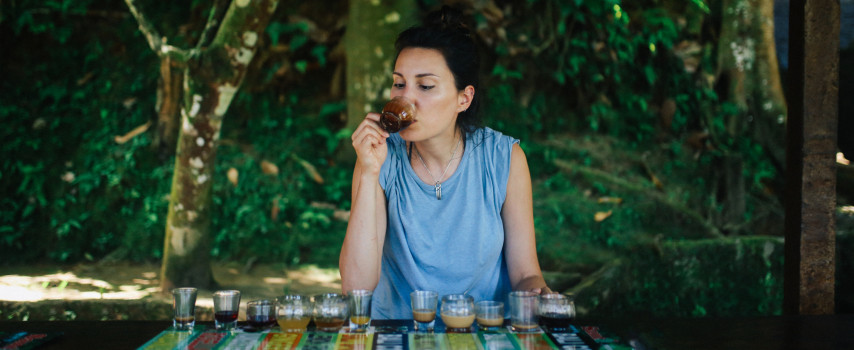
Source: Getty
Top culinary experiences: What to eat and drink Bali
Those who’ve been to Bali before know just how good the food is. Those who are yet to go, brace yourself for a culinary adventure.
Just one small island in a country made up of over 17,000 islands, Bali is not only home to its own cuisine and Indonesian traditions, but is influenced by the rich flavours of India, China and Malaysia. It’s also influenced by tourism, and these days finding an acai bowl, creative brunch or taco stand is as easy as finding authentic local delights.
From street food to fine dining, there is something here for every taste bud.
Read on for the must-try dishes in Bali, what to eat and drink, and where to find the best culinary experiences.
Traditional Indonesian and Balinese cuisine
Whether you’re dining at a local hotspot or fancy restaurant, you’re sure to find traditional dishes on the menu. Some of the must-try dishes include:
- Nasi goreng: an Indonesian fried rice with a variety of spices and toppings
- Rendang: a rich and spicy beef curry that originates from West Sumatra
- Sate (satay): an Indonesian staple, consisting of grilled skewered meat served with peanut sauce.
- Babi guling: this Balinese-style roast pork is a festival of crispy skin and succulent meat.
- Es campur: Bali's answer to beating the tropical heat, es campur is a refreshing concoction of shaved ice, condensed milk, and a variety of goodies like grass jelly, coconut, and avocado.
Street food
Indonesia is known for its vibrant street food culture, with countless vendors lining the streets selling a variety of snacks and meals. Some popular street food options include:
- Gado-gado (a vegetable salad with peanut sauce)
- Martabak (stuffed pancake)
- Bakso (meatball soup).
Café culture
Western culture has definitely influenced Bali’s dining scene, particularly when it comes to its creative café offering. Here are some of the best areas for Western dining:
- In the heart of Ubud, Monkey Forest Road boasts a charming array of cafes, where the brews are as artisanal as the art adorning their walls.
- Canggu's bustling Batu Bolong is a surfer's paradise, lined with bohemian cafes.
- For an Insta-worthy experience, head to the coastal haven of Seminyak, where you can pair your morning brew with Bali's famed smoothie bowls or smashed avocado creations.
Beach clubs
Bali’s beach clubs have redefined beachfront leisure for travellers, blending stylish lounging, live music, and culinary delights by the sand – and depending where you go, the sunsets are a show in themselves.
Seminyak is best known for its upscale beach clubs with gourmet dining, while Canggu offers more laid-back clubs that attract the surfing set.
Drinks to try
Coconut water is a refreshing and popular drink in Indonesia, especially during hotter months. Teh botol, a bottled sweetened jasmine tea, is also a popular choice among locals and tourists alike.
While exploring Indonesia, don't forget to also try out some of its famous Luwak Coffee. One of the world's most expensive coffees, luwak is produced using beans eaten and excreted by civets, offering a unique and smooth flavour.
If that’s a little too adventurous for your tastes, try traditional brews such as kopi tubruk (Javanese-style, strong and sweet) or kopi Bali (Balinese medium roast).
Cooking classes
Bali’s cooking classes are hands-on experiences where you'll discover the secrets behind Balinese cuisine, from spice blends to traditional techniques. Ubud, Seminyak, and Canggu are popular destinations for cooking classes, offering a chance to not only savour the local fare but also bring a piece of Bali's culinary magic back home with you.
A few tips about dining in Bali
When dining in Indonesia, it is important to remember some cultural customs:
- Most Indonesians eat with their right hand, using the left hand for personal hygiene.
- It is common to share dishes family-style and for everyone to take a portion from the same plate.
- It’s considered polite to leave a small amount of food on your plate as it shows that you are satisfied with the meal.
Finally, don't forget to read up on our tips to avoid Bali belly before you go.
Selamat makan! (Bon appétit!)

Source: Getty
Top Indonesian airports to fly into from Australia
Whether you're planning a beach vacation in Bali or an adventure trip through the jungles of Sulawesi, these major Indonesian airports are your best options for a seamless and convenient travel experience from Australia. With their modern facilities and efficient operations, you can start your Indonesian journey on the right foot by flying into any of these airports.
Pack your bags and get ready to embark on an unforgettable adventure in Indonesia!
Ngurah Rai International Airport (DPS)
Located in Bali, Ngurah Rai International Airport is the third busiest airport in Indonesia and the main gateway for tourists visiting the island. This airport offers a variety of international and domestic flights. It is also well-equipped with duty-free shops, restaurants, and lounges.
Soekarno-Hatta International Airport (CGK)
As the largest and busiest airport in Indonesia, Soekarno-Hatta International Airport serves as the primary hub for international and domestic flights. Located in the capital city of Jakarta, this airport is a popular choice for travellers flying from Australia to other destinations in Indonesia.
Juanda International Airport (SUB)
Located in Surabaya, the second-largest city in Indonesia, Juanda International Airport is another popular choice for travellers flying from Australia. It is the third busiest airport in Indonesia and offers a wide range of international and domestic flights.
Ngurah Rai International Airport (BDO)
Located on the island of Java, Ngurah Rai International Airport serves as the main gateway for visitors to the popular tourist destination of Bandung. This airport offers a variety of international and domestic flights, making it a convenient option for travellers from Australia.
Sam Ratulangi International Airport (MDC)
Located in the city of Manado on the island of Sulawesi, Sam Ratulangi International Airport offers both domestic and international flights, making it a convenient option for those looking to visit other parts of Indonesia.
How to get around Bali and beyond
With its diverse landscapes, vibrant cities and colourful cultures, there is much to explore in this beautiful South East Asian country. However, when it comes to getting around within Indonesia, travellers may find themselves a bit overwhelmed with the different transportation options available.
Your first taste of Indonesia comes straight after touchdown, and this can often be the most overwhelming part of the journey.
Avoid the stress and get a ride with an approved taxi (such as Bluebird Taxi) or organise a shuttle or private driver through your accommodation.
Once you’ve settled in, there are plenty of easy ways to get around Indonesia.
Bicycling
One of the best ways to explore Indonesia is by bicycle. The country is home to some of the most scenic bike routes, and it's a great way to immerse yourself in the local culture. Renting a bike is relatively easy and affordable in most cities and towns. You can also join a guided bike tour, which will take you through the local villages and rice paddies, offering insight into the traditional way of life in Indonesia.
Public Transport
There are various public transport options available in Indonesia, including buses, trains and trams, that are great for longer distances and connecting different cities. The bus network in Indonesia is extensive, and it's relatively cheap. However, buses can get crowded and may not always be the most comfortable option. Trains are a faster and more comfortable mode of transport, with air-conditioned carriages and sleeper options for longer journeys.
Taxis and Ride Apps
Taxis can be found in most cities, including on Bali. Bluebird Taxis are known to be reliable, honest and equipped with meters. However, during peak hours, it may be challenging to find an available taxi. Ride-hailing apps like Grab and Go-Jek are a convenient alternative, and provide upfront pricing, making it easier to budget your travels. With this means of transport it’s smart to always use a reputable company to avoid possible scams, avoid travelling alone at night, and familiarise yourself with the local currency and have small notes for paying fares to ensure you can get correct change.
Thinking of riding a motorcycle or moped in Bali?
Another popular choice for travellers is to rent a motorcycle or moped during their stay, with many rental companies offering daily, weekly and monthly rentals to suit your length of stay. This may offer the greatest freedom and flexibility to explore at your own pace, but it poses many risks too.
Motorcycle injuries are all too common – so much so that muffler burn and road-rash from accidents are colloquially referred to as the ‘Bali Kiss’.
If you plan to ride a motorcycle during your trip, keep in mind:
- An International Driving Permit is required (traffic police frequently issue fines to tourists without a permit)
- It’s smart to purchase travel insurance with motorcycle/moped cover, even if you’re just a passenger
- You must have a valid Australian motorcycle for your insurance policy to apply while renting a motorcycle or moped in Bali.
- Always wear a helmet
- If you’re not an experienced rider, don’t ride in Bali.

Source: Getty
Where to stay in Indonesia
Now you know the best time to visit Bali and other popular destinations across Indonesia – and what to do while you’re there – it’s time to decide where to stay.
First, are you in search of a tranquil beach town, a party atmosphere, serene mountainside, a diving wonderland, or a bustling city? Perhaps you’re looking for a taste of it all?
Accommodation across Indonesia ranges from backpacker budget to serious luxury at five-star hotels and everything in between. Resort stays or private villa rentals tend to be the most popular options for Aussie travellers, and with a good exchange rate, travellers can access upmarket accommodation for much less than it would cost back home.
Ready to start planning? These are the best areas to base yourself while exploring Indonesia.
Ubud, Bali
One of the most popular destinations in Bali, Ubud is the island’s cultural hub – and ‘green heart’. Surrounded by lush rice paddies, ancient temples, and traditional Balinese villages, it’s known for its eclectic arts scene and mouth-watering food, along with sightseeing experiences like the Monkey Forest and Pura Taman Saraswati Temple.
Seminyak, Bali
Located on the west coast of Bali, Seminyak is a trendy beach destination known for its luxurious resorts, upscale restaurants, vibrant nightlife, and designer boutiques. Spend your days exploring the beaches and open air markets, buy unique Balinese handicrafts or settle into a beach club. Nearby, the town of Canggu offers the same stunning coastline but with a more laid-back, surfer-friendly and bohemian vibe — a great option for those who want the location on a smaller budget.
Kuta, Bali
The little town with a big reputation. Kuta is undoubtedly Bali’s most famous beach resort town, and it’s home to plenty of activities for travellers and an energetic atmosphere that pumps long into the night. While this isn’t the place to come for peace and quiet, it’s a great area to stay if you’re looking to surf, shop or party.
Uluwatu, Bali
On the south-western tip of Bali’s Bukit Peninsula, Uluwatu is a must-visit thanks to its world-class surf breaks, rugged cliffs and dramatic beaches. Many travellers will day-trip here from other parts of Bali to explore Uluwatu Temple and kick back at a beach club, but it’s well worth basing yourself here for a few days – there are plenty of resorts, villas and hostels to choose from.
Lombok
Often referred to as “Bali 25 years ago, but with better beaches”, Lombok is home to Indonesia’s second-highest volcano – Mount Rinjani – along with stunning waterfalls and pristine beaches. It’s a slower pace than Bali, making it perfect for those seeking a peaceful escape, spectacular landscapes to hike, or breaks to surf.
Gili Islands
Fringed by warm azure waters, white sand and swaying palms, the Gili Islands are a group of three small islands off the northwest coast of Lombok – Gili Trawangan, Gili Meno and Gili Air. The sunsets here are magic, the scuba diving is some of the best in Indonesia, and the pace is much slower than what you’ll experience in Bali. In fact, there are no cars or motorbikes on these islands, so expect to get around on foot or bicycle.
The secret is out on the beauty of the Gili Islands, so while by no means are they considered ‘untouched’ as perhaps they were a decade ago, it’s a charming place to unwind.
Gili Trawangan is the most visited island, particularly by backpackers and younger travellers. Gili Air boasts the largest Indonesian population and attracts honeymooners and families. Gili Meno is the most remote, so come here if you want to really disconnect for a while.
Yogyakarta, Java
Yogyakarta is the cultural capital of Java, Indonesia's most populous island. Offering a unique blend of modern city life and traditional Javanese culture, it is home to ancient temples and palaces, as well as vibrant markets and a thriving arts scene.
Spend sunrise at Borobudur Temple, stand in awe of Prambanan Temple, feast your way along Miliboro Street, try sandboarding the dunes of Timang Beach, or get a rush exploring Jomblang Cave.
Bandung, West Java
Located in the highlands of West Java around 2.5 hours’ drive from Jakarta, Bandung is known as the city of flowers. Offering stunning highland scenery and a cooler climate, it is also a hub for fashion and culinary delights, making it a popular destination for both locals and tourists.
Sulawesi
Sulawesi is a holiday spot on the rise. Home to some of the world’s best diving among flourishing coral reefs, mountainous highlands and lush rainforests with native animals you won’t find anywhere else on earth, this is paradise for nature and wildlife lovers.
Makassar, the largest city on the island of Sulawesi, is a bustling port town with a rich history and diverse culture. It is also known for its delicious seafood and stunning beaches, making it a must-visit for foodies and beach lovers alike.
Manado, also located on the island of Sulawesi, offers a perfect mix of city life and natural wonders. From diving in the world-renowned Bunaken Marine Park to exploring traditional villages and markets, this neighbourhood has something for everyone.
Jakarta
Indonesia’s capital city, Jakarta, is a bustling metropolis where skyscrapers stand next to ancient temples and mosques. Come for incredible shopping, dining and nightlife, along with activities that immerse you in the country’s vibrant culture and fascinating history. Base yourself in Old Town for culture, Jalan Jaksa Street for budget travel and a thriving backpacker scene, Mentang to be close to major attractions, or the Sudirman CBD for luxury accommodation.

Source: Getty
12 things to pack for your Indonesian holiday
Whether you’re here for an intrepid adventure or a relaxed beach getaway, deciding what to pack requires careful planning and preparation. Discover the must-pack items to make your journey more comfortable and enjoyable.
#1. Lightweight clothing
Indonesia's climate is tropical, with high temperatures and humidity throughout the year – so it’s best to pack lightweight clothing made of breathable fabrics such as cotton or linen. Loose-fitting clothes will help keep you cool and comfortable in the hot weather.
Be sure to add these to your suitcase too:
- Swimwear to enjoy the beautiful beaches and water activities
- Sandals or thongs for easy removal before entering temples
- A sarong to cover up when entering temples and religious sites
- A nicer outfit if you plan to go to a nicer club or restaurant (dress codes apply at some upmarket venues)
- Consider your activities: if you’re planning to hike or visit the mountainous regions, such as Mount Batur, you’ll need sturdy footwear and extra layers for the colder climates.
#2. Wet weather gear
Indonesia experiences high rainfall throughout the year – even if you’ve timed your trip with the best weather to go to Bali. A lightweight rain jacket or compact umbrella will come in handy to protect you from sudden downpours and keep your belongings dry.
#3. Insect repellent
Being a tropical country, Indonesia is home to many insects that can be bothersome for tourists. Mosquitoes are prevalent and can carry diseases such as dengue fever and malaria, so have insect repellent on hand to protect yourself.
#4. Sun protection
The sun can be scorching in Indonesia, so bring a reef-safe sunscreen with a high SPF, sunglasses, and a wide-brimmed hat. These will not only protect you from sunburn but also prevent heatstroke and other heat-related issues. Aloe Vera gel or another after-sun product will come in handy if you do get burnt.
#5. Travel documents
It’s crucial to have all your travel documents in order before you travel. Make sure to bring your passport, airline tickets, and any other important documents related to your trip.
It is also recommended to make copies of these documents and keep them in a separate place from the originals, as well as digital copies saved to your phone or cloud storage. In the unfortunate event that you lose your passport or other important items, having copies can expedite the replacement process.
#6. Electronics
In this digital age, it's almost impossible to travel without electronics. Make sure to bring all necessary chargers and adapters for your devices.
A portable power bank is also helpful for those long days out and about when you can't find a place to charge your phone.
#7. Reusable water bottle
Stay hydrated and reduce your plastic waste by bringing a reusable water bottle. The tap water in most parts of the country is not safe for drinking, so make sure to refill your bottle with filtered or bottled water when needed.
#8. Medications
If you have a pre-existing medical condition or require regular prescription medication, you’re going to need to bring it with you on holiday. A few tips:
- Make sure to bring enough of your prescription medications for the duration of your trip, plus a little extra in case of potential travel delays or interruptions.
- Travel with a copy of your prescription and a doctor's note if you are carrying any controlled substances.
- Always check that your prescription medication is approved at your travel destination to avoid any issues during transit or at customs.
- It’s always wise to pack a basic first aid kit for any emergencies, including pain relievers, antihistamines, bandages, and medication for common stomach issues or traveller’s diarrhoea.
- Pharmacies, called ‘Apotek’ in Indonesia, are very common and easy to find in major destinations, including Bali, for any over-the-counter medication or toiletries you might need along the way.
#9. Cash and credit cards
While Bali and major cities in Indonesia have ATMs and credit card facilities, it’s still recommended to carry cash for smaller purchases, tipping and emergencies. Make sure to inform your bank of your travel plans to avoid any issues with using your debit or credit cards abroad.
It might be useful to sign up for a travel money card before departing Australia, as these typically have reduced fees or no fee when making international transactions.
#10. Comfort items for your flight
While flight times from Australia to Bali are much shorter than other international destinations, usually clocking in between 3 to 7 hours, consider bringing some of these travel essentials to ensure a smooth, relaxed journey:
- Travel pillow
- Sweater or extra layer
- Noise cancelling headphones or earplugs
- Eye mask
- Compression socks
- Lip balm, face mist or moisturiser to counter the dry cabin environment when flying
- Hand sanitiser.
#11. Travel insurance
While a lot can go right during your Indonesian adventure, there’s a chance things could go wrong too. If the unthinkable does occur during your trip, travel insurance may be able to help you get things back on track.
#12. Travel safety app
It’s handy to have a travel safety app on your phone, especially when you’re visiting a country that experiences natural disasters as frequently as Indonesia. Our Cover-More App is a good option – it gives you the ability to contact emergency assistance 24/7 through a tap-to-call "Assistance" button, and if you register your trip with the app it will also send you real-time safety alerts if there’s an incident in your vicinity.
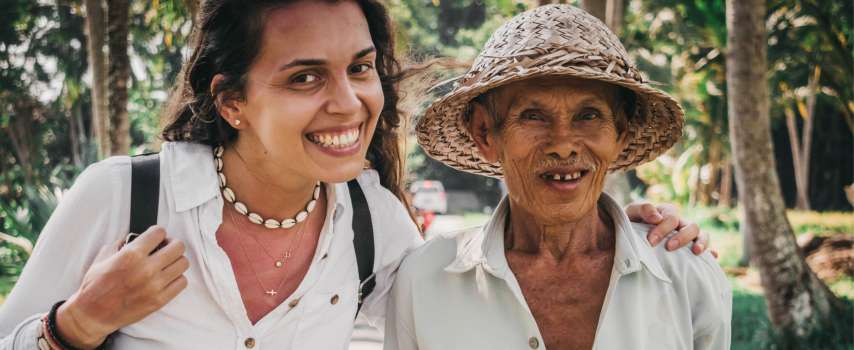
Source: Getty
16 phrases to know before you go to Bali
If you’re sticking to the main tourist drag while in Bali, you’ll probably get by speaking English – most Balinese people who live and work in popular destinations are familiar with English. But the beauty of travelling is connecting with locals and immersing yourself in the experience, and this is a whole lot easier if you learn a few local phrases in Indonesian before you arrive.
Here are the basics to get you started.
Greetings
#1. Selamat pagi: Good morning
#2. Selamat siang: Good afternoon
#3. Selamat sore: Good evening
#4. Selamat malam: Good night
#5. Apa kabar?: How are you?
#6. Baik, terima kasih: Good, thank you
Basic phrases
#7. Terima kasih: Thank you
#8. Sama-sama: You're welcome/It's okay
#9. Tolong: Please/Help me (depending on context)
#10. Maaf: Sorry/Excuse me
#11. Permisi: Excuse me (used when passing through a crowd or getting someone's attention)
Polite Expressions
#12. Tolong beri saya petunjuk?: Can you give me directions?
#13. Saya tidak mengerti: I don't understand
#14. Tolong ulangi lagi: Please repeat that
#15. Boleh saya foto?: May I take a photo?
#16. Maaf, boleh saya tanya?: Sorry, can I ask something?
It's important to note that Indonesians are generally very polite and use formal language when interacting with strangers or elders. So, it is best to use these polite expressions when communicating with locals.
Indonesians also have cultural customs such as greeting with a slight bow or hand gesture, especially when meeting someone for the first time.
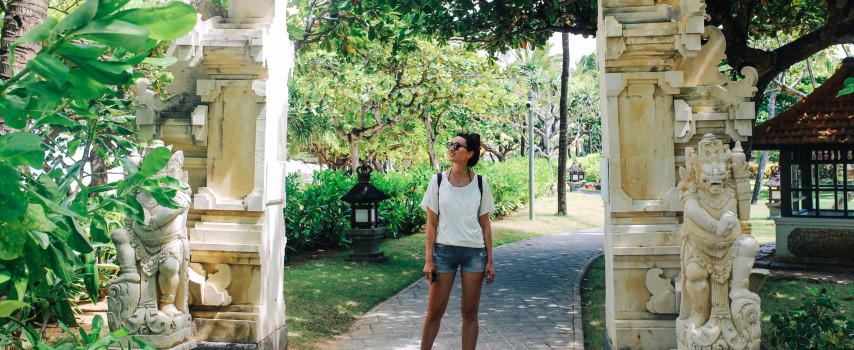
Source: Getty
9 public holidays in Indonesia that you should keep in mind
Local holidays are important to know when deciding the best time to visit Bali or other Indonesian destinations. On one hand, timing your trip for a national celebration is a unique opportunity to delve into the country’s fascinating, diverse and rich culture. On the other hand, public holidays in Indonesia may make certain destinations very crowded because of local travel, or popular attractions and activities may be closed.
Here are the public holidays in Indonesia to know before you book your travel:
#1. New Year’s Day
Just like in Australia, 1 January is celebrated as New Year's Day in Indonesia. People typically spend the day with their families, enjoying traditional meals and participating in local festivities, while many resorts and restaurants host parties and brunches for tourists.
#2. Chinese New Year
Because of its large Chinese population, Indonesia also celebrates Chinese New Year as a national holiday. This holiday falls on different dates each year depending on the lunar calendar and is celebrated with lion and dragon dances, parades, and traditional food.
#3. Day of Silence
Known as Nyepi, the Day of Silence is a unique and sacred Hindu holiday in Indonesia that typically falls on the night of a new moon during March or April, as it’s based on the ancient Saka Calendar. Nyepi marks the beginning of the Balinese New Year and is observed by practising silence, prayer, fasting, and meditation. The entire island shuts down for 24 hours, and no activities or transportation are allowed – including flights in and out of the airport.
If you’re travelling in Bali for Nyepi, this will be a day to relax and enjoy time at your resort as all other outside activities, restaurants and services will be closed. Alternatively, hop over to a nearby island where the holiday isn’t observed, such as the Gili Islands.
#4. Labour Day
Like in many other countries, Indonesia celebrates Labour Day on 1 May to honour the contributions of workers.
#5. Idul Fitri
Idul Fitri, also known as Eid al-Fitr, marks the end of the holy month of Ramadan for Muslims in Indonesia. It is a time of forgiveness, reflection, and gratitude, and is celebrated with prayers, family gatherings, and feasting. The date can differ year-on-year with the Gregorian calendar, though generally falls in April or May.
#6. Waisak Day (Vesak Day)
Waisak Day, also called Vesak Day, is a national holiday observed by locals in both Bali and Indonesia to honour and celebrate Buddha’s Birthday. Waisak Day is the holiest day on the Buddhist calendar, and while only around 1% of Indonesia’s population is Buddhist, everyone takes part in this public holiday that falls on the day of full moon in May.
While celebrations are held across the country, pilgrims famously gather at the Borobudur Temple in Central Java to perform rituals and celebrate the birth, enlightenment, and passing of Buddha.
#7. Pancasila Day
Held on 1 June, Pancasila Day commemorates the adoption of the five principles that serve as the foundation of Indonesia's national ideology. The day is marked with ceremonies and flag-raising events.
#8. Independence Day
On 17 August, Indonesia celebrates its independence from Dutch colonial rule with flag-raising ceremonies, parades, and traditional games and competitions.
#9. Christmas Day
Although Indonesia is a predominantly Muslim country, Christmas Day is still recognised as a national holiday, and is celebrated by the Christian population with church services, gift-giving, traditional meals and even fireworks. As this is a popular holiday travel period for Australians, many attractions will be open on Christmas Day – resorts and popular restaurants host lavish lunches, best booked ahead.
Ready to book your Bali trip?
Don’t forget to consider travel insurance before you set off.